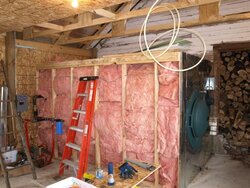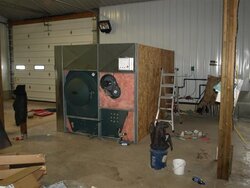Just be done with it and buy the Garn.
I sell and install several brands of wood burners, gasification and non gasification type and I have to say if I were to burn wood, it would be with a Garn without a doubt. They are no more expensive than any other gasification unit when you factor in purchasing 1,500-2,000 gallons of storage separately and they just flat out work. I have found that a Garn requires much less maintenance and "tinkering" than a typical EKO, Tarm, Econoburn etc. You literally just throw in the wood, set about 2-3 hours on the timer according to the wood load and weather and walk away. Presto, you're done for 8-12 hours. No muss no fuss, just load it and walk away. No wood hanging up in the fire box, no creosote or ash issues, the integral storage handles over temp situations with ease. (Unless you're REALLY crazy and load it full when your water temp is already 200*)
I hear back from customers with all types of wood burners ranging from typical OWB's (filthy burning wood eaters) to the top of the line gasifiers and the folks that I have installed Garn's for are universally happy.......no.....overjoyed, with the way their units work. I have one guy on a large dairy farm that we are presently installing Garn #3 for. All of 'em are WHS 2000's. He LOVES them!!. His wood use is even less than what I figured it would be much to his delight and what he is heating is far and away above anything considered normal. One of the units is heating the farm house which is 3,800 sq ft., old and drafty, heating domestic hot water for a family of 8, an 1,800 sq ft repair shop, the 800 sq ft farm office, the unattached 1,400 sq ft garage plus the chicken coop. That my friend is a load of heat and he told me last week that he has only burned about 11 face cords of wood so far this winter. If you could actually see what he is heating you would realize that is an incredibly small amount of wood for the load. He removes a 10 qt pail of ashes about every 7-8 days.
Garn #2 is heating the new dairy barn which consists of 3,700 sq ft of in slab radiant floor plus a 175,000 btu overhead hydronic heater. The barn has been under construction since November and as you can imagine the load on the Garn has been massive to say the least. (think plastic sheets covering the sides of the barn, open stud walls, doors open constantly...........but it's been able to maintain working temps (40-45*) in the building through out all but the coldest weather. Just load it and walk away. He's amazed, I'm amazed, neighbors stare in disbelief that it's able to keep up. One crusty of duffer who has a Central Boiler OWB even stated that the Garn is using no more wood than his unit does heating about 5,000 sq ft of well insulated house and shop.
Garn 3# will be piped in with #2 to provide additional heat for the dairy facility when we fire up another 4,000 sq ft of concrete slab in the outdoor holding area for the milk cows as they stage to enter the milking parlor. (we call it the poop melt zone) These two units will also provide approximately 700 gallons of 170* hot water PER DAY for washing and sanitizing the milking equipment. I have no doubt whatsoever that they will be up to the task.
The smallest Garn will provide a firing rate of 325,000 btu's and provide 1,500 gallons of storage. For a typical home or home and small shop totaling below 5-6,000 sq ft this is all you should need unless your living in an ice box like interior Alaska, upper Canada or Northern Minnesota. Do an actual heat loss calculation at your design temperature to find out what you actually need.
Garn is also coming out with a 25 year warranty for their units and it's bulletproof. You send in a water sample once a year, they send you the chemicals indicated by their analysis of your sample and your covered. Simple as that. The fact that I can show you units that have been is service for over 25 years with no failures should say something about the product also.
If your serious about burning wood for a long time, a Garn is definitely worth serious consideration. I've not run across anything that works as well or as simply.




